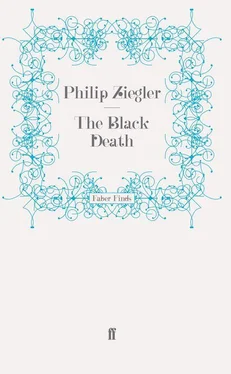The countryside around Hull seems to have been ravaged simultaneously by plague and by the flooding of the Rivers Hull and Humber. An inquisition post-mortem at Hemingbrough showed pasture normally worth 12d. trampled down and valueless. ‘The herdsmen were lying in the churchyard’. {370} All the bondigers and carters of the Abbey of Selby were dead so that turves and hay had to be carried by water. As for Hull itself, the King in 1353 remitted certain taxes: ‘…considering the waste and destruction which our town of Kingston-on-Hull has suffered, both through the overflow of the waters of the Humber and other causes, and that a great part of the people of the said town have died in the last deadly pestilence which raged in these parts and that the remnant left in the town are so desolate and poverty-stricken’. {371} At Wharram Percy the population of the parish was so reduced that, shortly after the Black Death, the side aisles of the church were pulled down and never rebuilt.
But in Yorkshire as elsewhere the structure of government was strained but substantially survived. A curious illustration of this comes from the city of York itself. On 7 August 1349 a jury certified that William Needler had died ‘a natural and not violent death by reason of the pestilence in Coppergate, York’. There must have been some decidedly suspicious circumstances about his death if, when so many were perishing, it was found necessary to conduct an inquest. But the fact that it was possible to assemble a jury and record a verdict according to the due processes of the law at a time when the epidemic in the city must have been at or near its peak is an impressive tribute to the civic sense of the inhabitants or, perhaps, to the discipline with which the authorities imposed their rule.
* * *
Lancashire was at this date one of the most thinly populated of the English counties. One area about which an unusual amount of information exists is the deanery of Amounderness to the west of the county, including the parishes of Preston, Lancaster and Blackpool. The Archdeacon of Richmond and his proctor, and Dean of Amounderness, had a dispute about certain fees for the probate of wills. A jury was set up to inquire into the question. They viewed the statistics presented to them with a certain amount of scepticism but no alternative totals were suggested and figures of this kind at least carry slightly more conviction than the vague calculations of the chronicles. In the ten parishes of Amounderness it was claimed, 13,180 people died between 8 September 1349 and 11 January 1350. In the parish of Preston 3,000 died, in Poulton-le-Fylde, it was said, 800 died; in Lancaster, 3,000; Garstang, 2,000 and Kirkham, 3,000. {372}
Even allowing for the enormous size of the parishes and some inflation in the estimates of the dead it seems that Amounderness must have suffered worse than the regional average. But evidence is scarce. At Rochdale where the parson died, there was a gap of eight months before the vacancy was filled, but this could be accounted for by inefficiency on the part of the diocesan authorities as well as by the high mortality. A curious entry is found in the Assize Rolls. A certain William of Liverpool ‘caused one third of the inhabitants of Everton to be brought to his house after death’; presumably with the intention of carrying out cut-price funerals and so cheating the lord of the manor and the church authorities. Since it was widely assumed that the plague was caught from the dead, his courage deserves praise as well as his business acumen. {373}
Of Cumberland still less is known. In this county, the diocesan registers are lacking; a tribute not so much to the Black Death as to the havoc wrought by the invading Scots. But though the Scots prepared the ground it was the plague which finally dislocated the agricultural economy. The accounts of Richard de Denton, former Vice-Sheriff, presented for audit in 1354, show vividly what damage had been done. Because of ‘the mortal pestilence lately raging in those parts’, he reported, ‘the greater parts of the manor lands attached to the King’s Castle at Carlisle’ were still lying uncultivated. For eighteen months after the end of the plague, indeed, the entire estate had been let go to waste ‘for lack of labourers and divers tenants. Mills, fishing, pastures and meadow lands could not be let during that time for want of tenants willing to take the farms of those who died in the said plague.’ The jury found that Richard de Denton had proved his facts and accepted the greatly reduced value of the estate. {374} The city of Carlisle was relieved of many of its taxes in 1352 because ‘it is rendered void and, more than usual, is depressed by the mortal pestilence’.
Durham too had suffered severely from the incursions of marauding Scots. In 1346 they had invaded in greater numbers than ever before. Under the sacred banner of St Cuthbert, Bishop Hatfield had taken the field and repelled them. But, though the victory was decisive, it had not come in time to save the Palatinate from devastation. Against such a background it is not surprising that the morale of the inhabitants should have been frail even before the threat of the Black Death became imminent. Durham is almost the only county in England where there is any evidence of panic spreading before the arrival of the epidemic and it is reasonable to see a link between this and the recent tribulations of the area. Yet even here no very dramatic evidence of demoralization is to be found.
That summer the halmote at Chester le Street opened as usual but when the Bishop’s steward arrived on 15 July at Houghton le Spring he found that accounts of the plague had spread dismay among the peasants. ‘There was no one’, it was recorded, ‘who would pay the fine for any land which was in the lord’s hands through fear of the plague.’ At Easington, the next centre for the halmote, things were even worse. The steward offered to make payment of rent contingent on the tenant’s survival of the plague but even this could not tempt the nervous peasants into taking on any new responsibility. In the end he was forced to let three tenements at an absurdly low rent since even this would be of greater benefit to the lord than to leave the land untilled. {375}
In his history of Durham, Surtees {376} described the Scottish invasion and concluded, ‘No other events than those related disturbed the peace of Hatfield’s Pontificate.’ The point of view which could thus lightly dismiss a calamity which killed perhaps ten times as many people as the battles with the Scots is hard to understand. But in justice to Surtees it must be admitted that few details are known. The usual pin-points of light illumine the great obscurity. Billingham was badly affected; forty-eight of the prior’s tenants were carried off, probably well over half the population. A laconic entry in the Bishop’s rolls records, ‘No tenant came from West Thickley because they are all dead.’ A peasant, driven mad with grief by the loss of all his family, wandered in search of them from village to village of the Palatinate. For many years his unceasing quest was to revive ugly memories throughout the countryside. {377}
It seems that in Durham relations between landlord and tenant suffered exceptionally as a consequence of the plague. Here too the damage done by the incursions of the Scots may have contributed to the malaise. At all events, while the Black Death was waning, something close to a strike took place in several villages of the Chester ward and harsh methods of repression had to be adopted. {378} Too little information survives to give any real idea whether this was no more than a spasm of resentment against an unpopular bailiff or a wider and more serious movement against authority; it is at all events, curious that the last county in England to be visited by the plague should have been the first to yield any evidence of rural disorder.
Читать дальше












